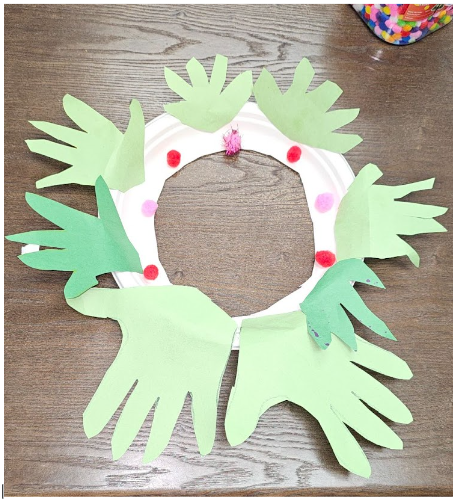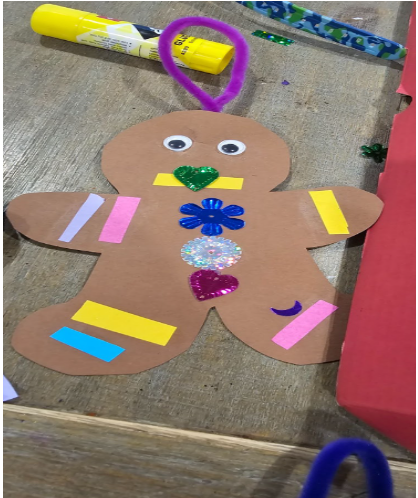Embracing the Holiday Magic: Inclusive Activities for Neuro-diverse Families
The holiday season is a magical time filled with warmth, joy, and the spirit of togetherness. For families with neurodiverse children, creating inclusive and sensory-friendly traditions is key to making this time of year special. Here are five delightful activities that cater to different interests and abilities, ensuring that every member of the family can join in the festive fun.
-
Description: Create a festive handprint wreath to enhance your holiday decor. This inclusive craft is suitable for all ages, offering a delightful and mess-free way to celebrate the season.
Materials Needed:
Colored paper
Glue or tape
Scissors
Circular base (cardboard, heavy paper, or paper plate)
Pom poms (optional)
Instructions:
For Older Children:
Independent Crafting:
Provide colored paper, glue, and scissors for older children to trace, cut, and arrange handprints into a wreath shape.
Creative Expression:
Encourage exploration of colors and patterns, fostering creativity.
For Younger Children:
Pre-cut Handprints:
Simplify by pre-cutting handprints from colored paper.
Guided Crafting:
Guide younger children in gluing pre-cut handprints onto a circular base, promoting fine motor skills and collaboration.
Adaptations:
Adjust for age and skill level, allowing for independent or collaborative crafting.
Consider using textured or scented paper for added sensory engagement.
Display and Enjoy: Showcase the handprint wreaths proudly, capturing the unique contributions of each participant. This inclusive craft beautifully embodies the holiday spirit, accommodating both older and younger children.
-
Description: Get into the festive spirit with this mess-free paper craft – a creative alternative to traditional gingerbread decorating. Ideal for all ages and abilities, this delightful project lets everyone express their holiday creativity without the need for baking.
Materials Needed:
Gingerbread man templates (printed or drawn on sturdy paper)
Markers, crayons, or colored pencils
Glue
Assorted decorations: sequins, buttons, glitter, ribbon, etc.
Instructions:
For Older Children:
Independent Design:
Provide materials for older children to design intricate patterns and unique features on their gingerbread men.
Advanced Embellishments:
Challenge them to experiment with different textures and layers, exploring creative ways to enhance their creations.
For Younger Children:
Pre-cut Templates:
Offer pre-cut gingerbread men templates for easy decorating, perfect for younger children.
Guided Decorating:
Guide younger children in using markers or crayons to add colors and simple patterns.
Collaborative Creativity:
Embrace collaborative creativity by involving younger children in group discussions on decorating ideas and themes.
Adaptations:
For those not ready for scissors, provide pre-cut gingerbread men templates for easy decorating.
Adjust the complexity based on individual abilities.
Share and Display: Display the festive creations to spread holiday joy – colorful and uniquely designed gingerbread men that cater to both independent older children and the collaborative efforts of the younger ones.
-
Description: Turn baking into a sensory-rich experience by decorating sugar cookies.
For Children with Advanced Skills: Bake and cool the cookies ahead of time. Set up a decorating station with various toppings like icing, sprinkles, and edible decorations, allowing them to express their creativity freely.
For Younger Children: Pre-bake the sugar cookies and provide pre-made icing in squeeze bottles. Guide them by squeezing the icing onto the cookies and sprinkle decorations. This simplifies the process while still fostering sensory engagement.
Cookie Recipe:
Here's a simple sugar cookie recipe that parents can enjoy making with young children. This recipe is easy to follow and allows for plenty of hands-on fun and creativity while baking.
Ingredients:
1 cup (2 sticks) unsalted butter, softened
1 cup granulated sugar
1 large egg
1 teaspoon vanilla extract
3 cups all-purpose flour
1/2 teaspoon baking powder
1/4 teaspoon salt
Instructions:
Preheat the Oven: Preheat your oven to 350°F (180°C). Line baking sheets with parchment paper.
Cream Butter and Sugar: In a large bowl, cream together the softened butter and granulated sugar until light and fluffy. This can be done using a hand mixer or stand mixer.
Add Egg and Vanilla: Beat in the egg and vanilla extract until well combined. Scrape down the sides of the bowl to ensure all ingredients are incorporated.
Combine Dry Ingredients: In a separate bowl, whisk together the flour, baking powder, and salt.
Mix Wet and Dry Ingredients: Gradually add the dry ingredients to the wet ingredients, mixing until a soft dough forms. Be careful not to overmix.
Chill the Dough (Optional): For easier handling, you can chill the dough in the refrigerator for about 30 minutes. This step is optional but can make it simpler for young children to work with the dough.
Rolling and Cutting: On a floured surface, roll out the cookie dough to about 1/4 inch thickness. Provide cookie cutters for children to cut out fun shapes.
Baking: Place the cut-out cookies on the prepared baking sheets, leaving some space between each cookie. Bake in the preheated oven for 8-10 minutes or until the edges are lightly golden.
Cooling: Allow the cookies to cool on the baking sheets for a few minutes before transferring them to a wire rack to cool completely.
Decorating: Once the cookies are completely cool, let the decorating fun begin! Provide icing, sprinkles, and other edible decorations for children to use their creativity.
Enjoy these simple and delicious sugar cookies made with love and laughter!
-
Description: Transform your living room into a winter wonderland with the Inclusive Snowman Building Challenge, a game that encourages creativity, teamwork, and laughter.
Materials:
White pillowcases or sheets
Assorted scarves, hats, and accessories
Adhesive Velcro strips or safety pins
Felt or construction paper for additional decorations
Blindfold (optional)
Instructions:
Setting Up:
Prepare Snowman Pieces:
Cut the white pillowcases or sheets into large circles to represent snowman bodies. Adjust the size based on the space available and the age of the children.
Use Velcro strips or safety pins to attach the circles together, allowing for easy stacking.
Gather Accessories:
Collect scarves, hats, and various accessories for decorating the snowmen.
Consider adding felt or construction paper features like eyes, noses, and buttons.
Playing the Game:
Divide into Teams:
Divide the participants into teams, ensuring a mix of ages and abilities in each group.
For children with advanced skills, encourage them to take on leadership roles or guide their teammates.
Blindfold Variation (Optional):
For an extra challenge and sensory experience, consider blindfolding one member of each team. This encourages communication and teamwork as they guide the blindfolded teammate in placing the snowman pieces.
Building Snowmen:
Set a timer and challenge each team to build the most creative and festive snowman within the allotted time.
Encourage collaboration and inclusion, making sure every team member has a role in decorating the snowman.
Showcasing the Snowmen:
Once the timer goes off, each team presents their snowman to the group.
Celebrate the unique features and creativity of each snowman.
Awarding Prizes (Optional):
Consider giving out small prizes or certificates for categories like "Most Creative," "Best Use of Accessories," or "Teamwork Award."
Adaptations:
Adjust the size of the snowman pieces to accommodate different abilities and mobility levels.
Provide a variety of textures for decorations to appeal to sensory preferences.
The Inclusive Snowman Building Challenge is a delightful game that fosters teamwork, creativity, and a sense of accomplishment. Whether your snowmen are towering masterpieces or charmingly petite, the joy of collaboration and friendly competition will make this activity a memorable addition to your inclusive holiday traditions.
-
Description: Embark on a captivating journey into the world of holiday storytelling, designed to delight children of various ages and abilities. The Inclusive Sensory Storytelling Experience offers a literary adventure that not only kindles a passion for stories but also embraces the unique needs of every child. Whether they're immersing themselves in the joy of reading or discovering the wonders of sensory elements, this activity creates a festive tradition that warmly welcomes the entire family.
Instructions:
Setting Up:
Select a Story:
Choose a holiday-themed book that suits the interests and comprehension levels of all participants. Opt for books with engaging narratives and vibrant illustrations.
Some suggestions are:
"The Polar Express" by Chris Van Allsburg
Follow the enchanting journey of a young boy on the Polar Express train to the North Pole.
"How the Grinch Stole Christmas!" by Dr. Seuss
Join the Grinch as he discovers the true meaning of Christmas in Whoville.
"The Nutcracker" by E.T.A. Hoffmann
Dive into the classic tale of Clara and her magical journey with the Nutcracker Prince.
"A Charlie Brown Christmas" by Charles M. Schulz
Share the heartwarming story of Charlie Brown as he discovers the true spirit of Christmas.
"The Snowman" by Raymond Briggs
Experience the magical friendship between a boy and a snowman that comes to life.
"The Gingerbread Man" by Jim Aylesworth
Enjoy the timeless story of a gingerbread man who escapes and embarks on a lively adventure.
"The Night Before Christmas" by Clement C. Moore
Set the holiday mood with this classic poem that captures the anticipation of Christmas Eve.
"Bear Stays Up for Christmas" by Karma Wilson
Join Bear and his friends as they celebrate Christmas together in this heartwarming tale.
"Frosty the Snowman" by Steve Nelson and Jack Rollins
Follow the adventures of Frosty, the beloved snowman who comes to life with a magical hat.
"The Mitten" by Jan Brett
Delve into the snowy world of a lost mitten and the surprising animals that seek shelter inside.
To expand your collection of holiday-themed books, check out your local library for a wide range of options.
Create a Comfortable Space:
Arrange a cozy reading area with soft blankets and cushions to provide a comfortable space for everyone.
For Children with Advanced Skills:
Reader's Choice:
Allow children with advanced skills to take turns reading aloud from the chosen holiday book. This promotes language development, confidence, and social interaction.
Enhance the Experience with Sensory Elements:
Integrate sensory elements like scented candles or essential oils that align with the holiday theme. This can create a multisensory experience and add a layer of enjoyment for participants.
For Younger Children:
Interactive Storytelling:
Read a short, engaging holiday story with colorful illustrations. Use expressive tones and varied pitches to maintain their interest.
Incorporate Props and Sensory Toys:
Enhance the storytelling experience by introducing interactive props or sensory toys related to the story. For example, if the story mentions snow, provide soft, textured fabrics to touch during those parts of the story.
Encourage Participation:
Pause at key moments in the story to encourage younger children to engage with the props or toys. This not only captures their attention but also promotes active participation.
Adaptations:
For children with visual impairments, consider using tactile books or incorporating textured objects relevant to the story.
Adjust the length of the storytelling session based on the attention spans of the participants.


